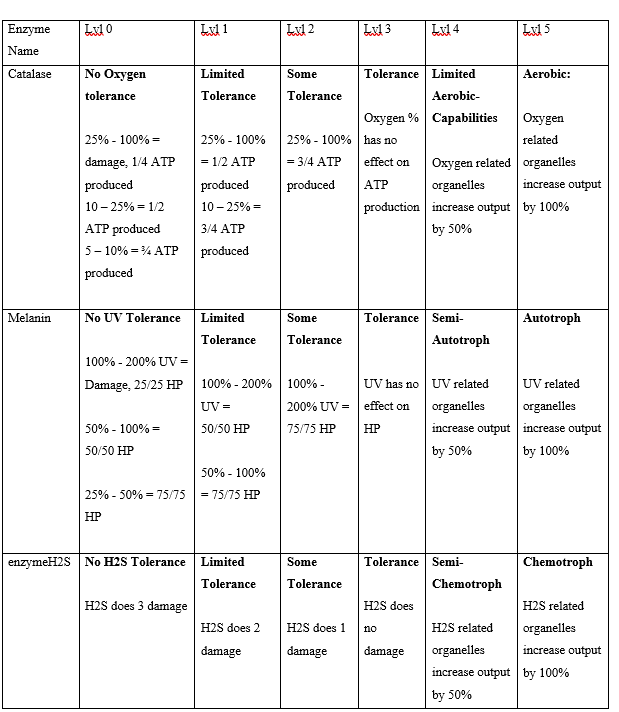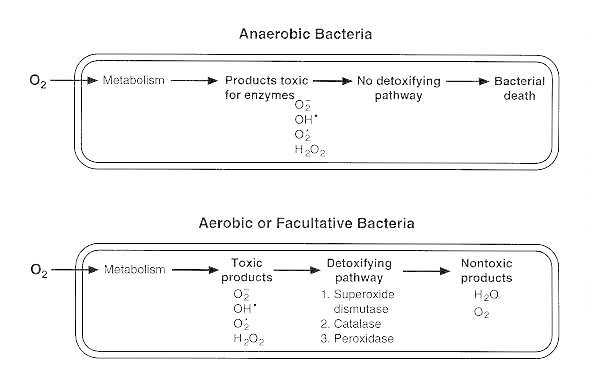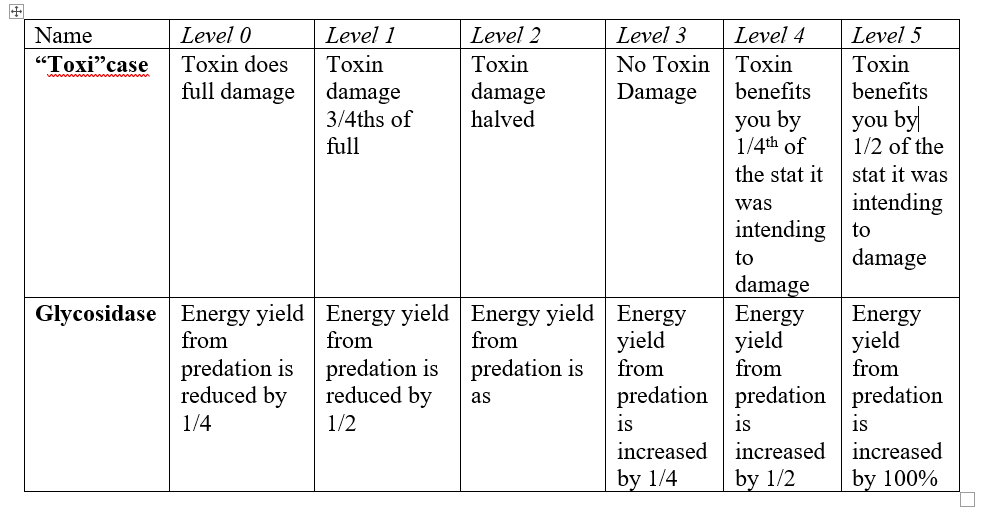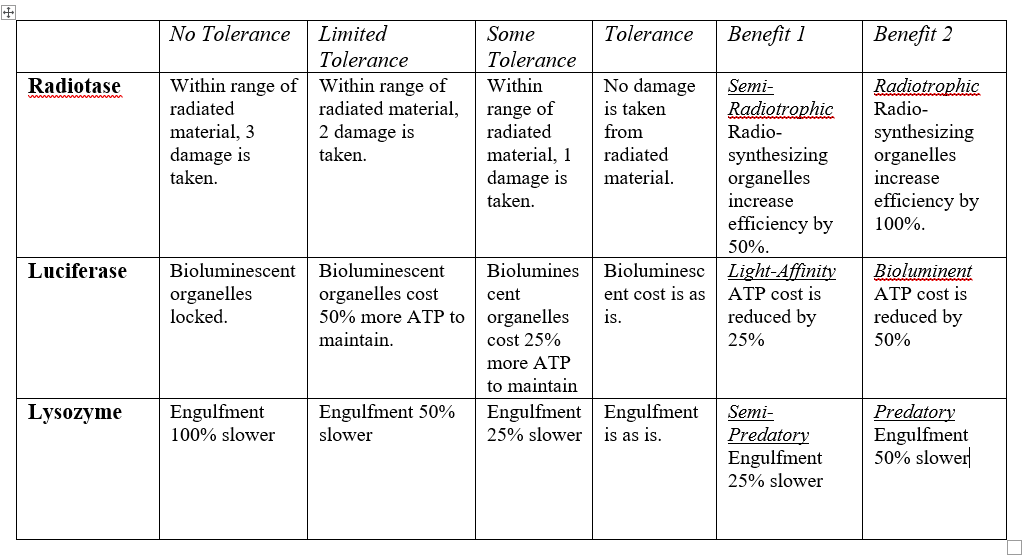Looking over the development forum, I took a particular interest towards the conversation regarding enzymes. As a result, I have made a general concept which I feel could be of interest.
As is established, enzymes will be used to mitigate the effects of damaging compounds to the cell. Although they are an essential component of all cells, they do not have an extensive presence in the microbe stage as of now. It seems that this is mostly due to a lack of consensus regarding how to implement enzymes. I suggest that enzymes, specifically upgrading and balancing them, could be an important component of the microbe stage.
As of now, the general plan regarding enzymes revolves around utilizing them to mitigate the detrimental effects of certain environmental compounds. For example, catalase, an buffer against the damaging effects of oxidation, has been proposed, and its inclusion could essentially create the mechanics needed for a Great Oxygenation Event. The thing about enzymes, however, is that they aren’t necessarily an organelle, making it hard to implement as simply another tool to add in the cell editor. This wouldn’t really make any sense anyways; enzymes are extensively utilized in all life and do not take up a significant amount of space within cells. A slot system has also been proposed, and while this does solve the problem of space, the concept of a slot doesn’t really align with established Thrive mechanics. To solve this problem regarding the implementation of enzymes, I propose that enzymes should be the introduction to the upgrading system that I believe should be an important component of how Thrive develops conceptually.
This concept depends on the idea that compounds such as oxygen, hydrogen sulfide, sunlight, etc. will negatively affect you at certain percentages.
I will be using three enzymes to illustrate this concept: catalase (oxygen), melanin (sunlight), and enzymeHS (hydrogen sulfide). Note that these enzymes might not necessarily correspond to their respective compounds in real life, I’m just trying to make a point.
Hydrogen sulfide’s effects on the cell is the easiest to understand. If you wander into a cloud of hydrogen sulfide with no adaptations to it, your cell will take damage as long as it stays in the cloud. For more atmospheric compounds, such as Oxygen and Sunlight, there will be certain thresholds (as mentioned on the development forums) at which certain effects begin to show; for example, at 5% of compound x, y will start to happen, at 10% of x, z will happen, etc. Oxygen effects on the cell will reduce the amount of ATP generated within the cell; the effects start at 5%, and only escalate from then on. Light at 20% reduces the total health of a cell (from 100/100 to something like 75/75); the effect rises in impact as the light exposure % increases, to the point that sunlight will eventually damage a cell (in conditions such as a tidepool).
The enzymes which combat the effects of these compounds shall be presented as upgradable options within cell editor, with upgrade “levels” in each enzyme earned by allocating points. Below is a rough concept.
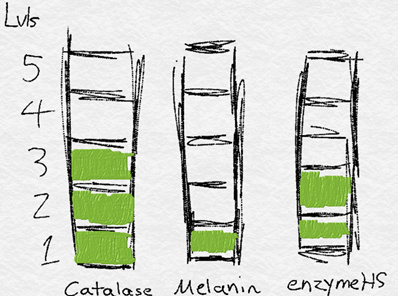
The player will distribute a set amount of points into each of these enzymes, so they would have to wisely allocate their points according to what their cell needs the most. With each level comes an increased resistance to the detrimental effects of a certain compound. In general for each enzyme, level 1 and 2 reduces the effects of a detriment, level 3 completely mitigates the detriment and increases the efficiency of the organelles associated with the enzyme’s compound, and level 4 and 5 adds on to this efficiency. As a player’s population continues to grow, they will be given more upgrading points; this caps at around 10 UP.
Below is a general concept of what I have thought of so far.
With this system implemented, I feel that upgrades have been implemented in a way which extends the depth of the game and helps simulate evolution while providing a way to balance against organelle gluttony in a way that doesn’t take away that much from the sandbox aspect of Thrive. I feel that the system is robust enough to simulate various natural phenomena and specific enough to limit the player’s autonomy in a way that is as limited and fun-purposed as possible.
With this in mind, imagine starting in those hydrothermal vents. In the first generation, although life is pretty easy, you still have to be wary of those H2S clouds. When you visit the editor, you have 3 upgrade points available, which gives you enough to begin the process of specialization. A player that intends to maximize their advantage (who starts on a planet akin to Earth in that it has limited oxygen initially) would likely either invest in tolerance for H2S and begin to tussle with other species in the vents or specialize in melanin and rush to the barren, sunlight rich biomes above them. They can then pick and choose to specialize in whatever they believe would serve them best in their environment. When Oxygen begins to increase in the environment as a result of the rise of photosynthesis, the need to invest in Catalase will now be apparent, and the player will then have to make a choice; they could either suffer through the detrimental effects of O2 by reducing their cell’s features, or begin to invest in catalase. A player who was pretty successful before this point could possibly have enough MP to generally spare them a bit of heart-ache when it comes to re-distributing their upgrade points, as they have earned a few extra; a player who is less successful would likely have to make a hard choice, as they have less of a cushion.
Imagine an event, such as a catastrophic volcano eruption or a meteor impact, which increases the prevalence of H2S in the environment and reduces the amount of light available. Players could use this opportunity to invest in enzymeH2S at the expense of Melanin, as the latter wouldn’t really have a use in the environment. They could also use this opportunity to fully invest in catalase as well, which unlocks the full utility of oxygen related organelles.
There are a few problems with this concept that I could see. If a player is in an environment which basically only needs the specialization of one enzyme, they basically have 5 extra upgrade points which are useless. I feel that this can be solved by adding more enzymes which deal with other attributes (such as temperature and radiation), but I don’t really have a concept for those two established YET. For now, I want to see if the general idea holds up to scrutiny.
Any thoughts, suggestions, critiques?
